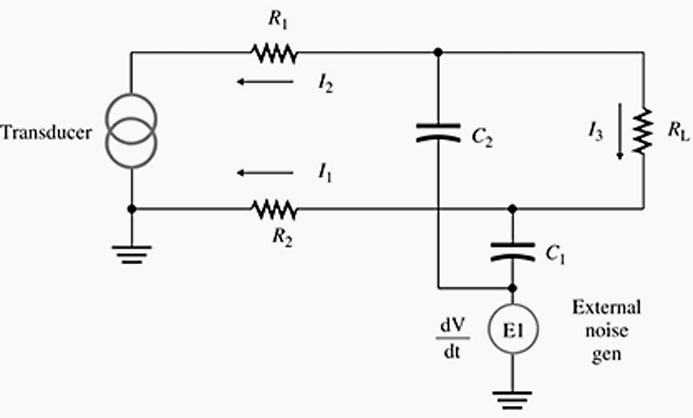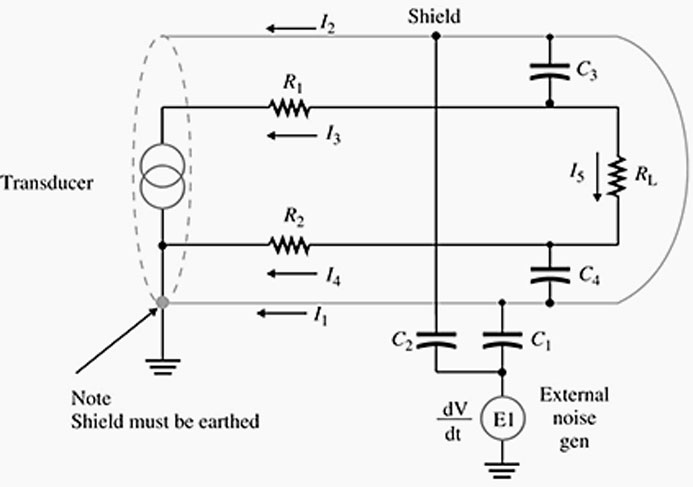What is Induced Noise?
Induced noise is the noise generated in a circuit by a varying magnetic or electrostatic field produced by another circuit.
Induced noise, just like any other electrical noise, degrades the useful signal and may lead to equipment errors, shutdown, or malfunction. This is more critical in digital circuits, signal transmission circuits and other sensitive circuits.
The induced noise is produced by an externally generated energy that couples itself onto the other equipment. Once this electrostatic or magnetic energy gets in the equipment, the energy is converted to noise in the signal cables, power cables, spaces between some sensitive components, or between PCB tracks.
Three conditions must be met for noise to be induced in an equipment or circuit. There must be:
- Source of the noise voltage signal
- A coupling mechanism
- The circuit conveying the desired signal
Types and sources of induced noise
The most common types of induced noise are the electromagnetic noise which is magnetically coupled, and electrostatic noise, which is capacitively coupled from the source to the good circuit.
Electromagnetic noise
The varying magnetic fields produced in nearby equipment induce current in the conductors of the affected equipment. Common sources for these magnetic fields include:
- AC power cables
- Cables in variable frequency drive motors
- Ground loops
- Power contactors in solenoids
- Conductors in switched mode power supplies
Electrostatic noise
This noise is generated by the varying electrostatic fields from:
- Fluorescent lights
- Conductors in switched mode power supplies
- Squealing bearings
- Cables in VFD motors
Figure 1: Capacitive coupling through C1 and C2 – Image Credit
How to reduce the effect of induced noise
Since the noise generator is outside the equipment, the best way to minimize is reducing the emission levels at the source, or ensuring that the receiver is well designed or protected. However, this may not be possible for all types of noise.
For the noise to be induced, a receiver must be susceptible, and one solution is to reduce its sensitivity by
Using twisted pair cables
This eliminates the normal mode noise since each of the conductors is exposed to the same amount of electromagnetic or electrostatic noise, however, the noise in each cable is opposite to the one in the other cable such that they cancel out and the and effective result becomes zero. In twisted wires, the noise voltages that are induced in the signal wires usually cancel out with each other.
Best practices in design and installation of equipment
Adhering to manufacturer’s recommendations and best practices when designing circuits as well as when installing equipment such as motors, it is important to pay attention to instructions such as grounding and shielding of the cables. In addition, use of carefully selected components and using best practices in designing the circuit layout is one of the best ways of minimizing the induced noise in equipment.
Proper grounding
Proper grounding eliminates some of the noise problems. Establishing a common ground for all the components or circuits of a system can help reduce the noise. This ensures that the system has the same reference potential for all the different voltages and signals. The ground plane should then be bonded to the earth ground so that there is a return path for ground faults. In addition, the earth ground provides a zero potential reference, hence minimizing noise from high frequency sources such as the RF.
Signal isolation
For systems with multiple circuits, it is important to isolate the noisy devices to ensure that the signal wiring does not create a ground loop by providing a return path between the ground planes.
The isolation is only required where any of the devices has the potential to create a ground loop.
Shielding
Induced noise is minimized by shielding the equipment as well as the wires. The shield provides a low resistance path for the noise voltage signal. When the shield is grounded, which should be the case; the noise signal is grounded and does not reach the equipment. It is recommended the one uses a low resistance shield material such as copper or aluminium.
Figure 2: shielding to prevent induced noise in a circuit – Image Credit
Conclusion
Induced noise is one of the challenges in electronic equipment; it affects the efficiency and sensitivity of the affected circuit and may lead to equipment malfunction. However, it is possible to control and minimize the effect of the induced noise by identifying and reducing the noise voltage at the source. In addition, proper equipment and circuit design gives them the ability to withstand the noise voltage.

